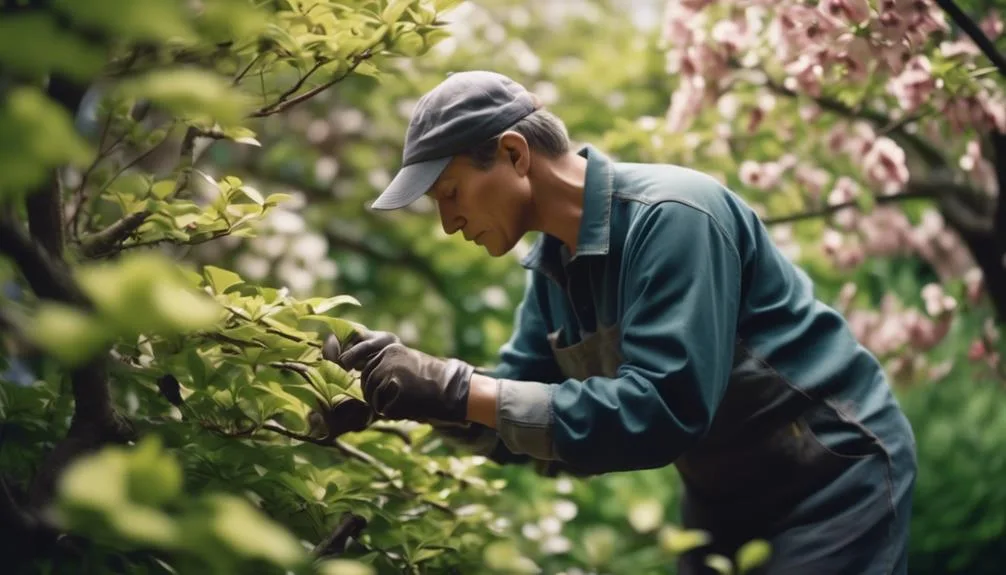Caring for dogwood trees may seem simple, but it's actually a precise art that demands attention to detail.
From planting to pruning, these trees require careful nurturing.
Whether you're new to gardening or an experienced enthusiast, mastering dogwood care will enhance your skills.
Ready to learn the secrets of keeping these majestic trees vibrant?
Planting Dogwood Trees
When planting Dogwood trees, carefully select a location that receives partial shade and well-drained soil to ensure the best conditions for growth. Dogwoods prefer acidic, well-draining soil, so adding compost or peat moss can be beneficial. Prepare the soil by mixing in organic matter to improve drainage and fertility. When it comes to spacing, ensure that each tree is planted at least 4-6 feet apart to allow for ample room for growth.
Dogwoods thrive in partial shade, especially during the hot afternoon hours, so it's crucial to consider the sunlight requirements when choosing a planting spot. Once planted, mulch around the base of the tree to help retain moisture and regulate soil temperature. Keep the mulch about 2-4 inches deep, but ensure it doesn't touch the trunk to prevent rot.
Watering and Fertilizing
To ensure the health and vitality of your Dogwood trees, it's essential to understand the proper methods for watering and fertilizing.
Water your Dogwood tree regularly, especially during dry periods. Deep, thorough watering encourages deep root growth and helps the tree withstand drought. Apply a layer of mulch around the base of the tree to retain moisture and regulate soil temperature.
When fertilizing, choose a balanced, slow-release fertilizer to provide essential soil nutrients without promoting excessive growth. Dogwood trees have a moderate growth rate, and over-fertilization can lead to weak, leggy growth. Avoid fertilizing in late summer to prevent stimulating new growth that may not harden off before winter.
Pruning and Trimming
Prune and trim your Dogwood trees regularly to maintain their health and vitality. Building on the foundation of proper watering and fertilizing, this will promote strong, well-shaped growth. When pruning, focus on enhancing the branch structure by removing any dead, diseased, or crossing branches. This not only improves the overall appearance but also helps prevent the spread of diseases and encourages better air circulation.
Seasonal timing is crucial for pruning Dogwood trees. It's best to prune during late winter or early spring while the tree is still dormant. Avoid pruning in the fall as it can make the tree more susceptible to diseases. Additionally, summer pruning should be limited to removing dead or damaged branches.
Proper pruning and trimming will help your Dogwood trees flourish and maintain their natural beauty.
Managing Pests and Diseases
To keep your Dogwood trees healthy and vibrant, it's important to be proactive in managing pests and diseases that can potentially affect them. Here are some essential tips for pest control and disease prevention:
- Regular Inspection: Check your Dogwood trees frequently for any signs of pests or diseases such as discolored leaves, strange spots, or wilting branches. Early detection can help in preventing the spread of issues.
- Pruning and Sanitizing: Regularly prune any affected or dead branches and sanitize your pruning tools to prevent the spread of diseases.
- Natural Predators and Beneficial Insects: Encourage natural predators and beneficial insects in your garden, such as ladybugs, lacewings, or predatory mites, to help control pest populations without harsh chemicals.
Winter Care and Protection
As winter approaches, it's crucial to prepare your Dogwood trees for the harsh conditions to ensure their health and vitality in the coming season.
One important aspect of winter care is mulching. Applying a layer of winter mulch around the base of the tree helps to insulate the roots, retain moisture, and protect them from extreme temperature fluctuations. Use organic materials such as straw, wood chips, or shredded leaves for effective insulation.
Additionally, consider providing frost protection for your Dogwood trees. During sudden temperature drops, cover young or vulnerable trees with frost cloth or burlap to shield them from freezing temperatures and harsh winds.
Conclusion
Incorporating these essential care practices will ensure your dogwood trees thrive and grace your garden with their beauty for years to come.
By planting in well-drained soil, regular watering and fertilizing, mindful pruning, and winter protection, you're nurturing a lasting source of joy.
How will your beautifully cared-for dogwood trees inspire your garden's natural splendor?

My interest in trees started when I first saw the giant sequoias in Yosemite.
I was a teenager then, and I remember thinking, “I need to learn more about this.”
That moment stuck with me.
A few years later, I went on to study forestry at Michigan Tech.
Since graduating, I’ve worked in a mix of hands-on tree care and community education.
I’ve spent over ten years helping people understand how to plant, maintain, and protect the trees in their neighborhoods.
I don’t see trees as just part of the landscape.
They are living things that make a real difference in our daily lives.
